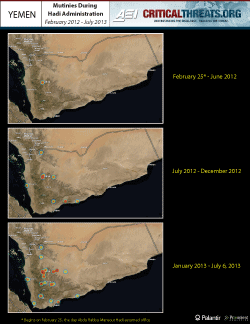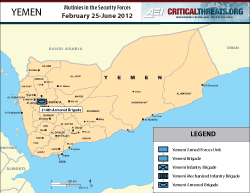{{currentView.title}}
July 10, 2013
Mutiny in the Yemeni Military
The Yemeni military has long been weakened by corruption, fragmentation, and instances of insubordination, but in the past year and a half its soldiers have been bucking orders and casting out commanders at an increasingly faster rate. Even elite units placed in sensitive areas, for instance in territory where al Qaeda in the Arabian Peninsula (AQAP) is known to operate, have left their posts. If this trend continues to accelerate, it risks knocking out a vital pillar of U.S. counterterrorism strategy.
The United States relies on the Yemeni security forces to conduct counterterrorism operations against al Qaeda in the Arabian Peninsula (AQAP) as part of America’s strategy to combat the virulent Yemen-based al Qaeda affiliate. The partnership with the Yemeni government previously ran through Ali Abdullah Saleh, who carefully managed the counterterrorism relationship and channeled American military assistance to members of his family and patronage network. Former president Saleh was an unreliable partner: his prioritization of limited security resources created a permissive environment for al Qaeda to re-establish itself in Yemen. Political unrest sparked by the Arab Spring in 2011 forced Saleh into a negotiated transition of power to his vice president, Abdu Rabbu Mansour Hadi. The transition deal, inked under the auspices of the Gulf Cooperation Council, included a mandate for Hadi to restructure Yemen’s security sector. Hadi’s efforts to dismantle entrenched patronage networks and to professionalize a force long accustomed to personal rule have met resistance, however. Though the U.S. may now have a willing partner in Yemen, that partner is currently handicapped by regular instances of insubordination within the ranks of its military.
 |
 |
Mutinies have occurred across Yemen, sometimes on highly sensitive fronts like Abyan and Ma’rib governorates.[3] The northeastern region of Abyan has been a historical safe haven for al Qaeda in Yemen, and in 2011, AQAP’s insurgent arm seized control of most of Abyan governorate. Military units in Abyan currently serve as the frontline against AQAP’s insurgency, which has not yet been fully put down. Ma’rib, the governorate east of Sana’a, the capital, has also had a historical al Qaeda presence. Its tribes work with AQAP and grant members of the organization safe passage and refuge. Tribesmen in Ma’rib have also repeatedly targeted national energy infrastructure to protest against the government, causing widespread power outages. Troops in Ma’rib provide security for repairs on the damaged power stations and oil pipelines, as well as limit AQAP’s freedom of movement in the governorate.
 |
One of the worst cases of mutiny occurred in Ma’rib governorate, and actually ended in the effectual disbandment of an entire brigade. The soldiers in the Third Mountain Brigade, a former Republican Guard unit, rose up in February 2013 and appointed their own commander.[4] The soldiers acted out consistently in the months since: scrapping with local merchants, blocking a main road, and even clashing with military police.[5] After months of violence, the Defense Ministry sent in a mediation committee that decided to give the rebelling brigade six months’ leave, whereupon its soldiers sold their weapons on the local marketplace and left the governorate.[6] A June 25 report indicated that a brigade of soldiers from the former First Armored Division, only now in the process of disbanding and vacating its Sana’a-based headquarters, would be deployed to Ma’rib to replace the dissolved Third Mountain Brigade.[7] The failures here are many, and include the original acceptance of a commander appointed outside the chain-of-command; negotiations with troops that added legitimacy to their protest; and the chaotic dissolution of an elite unit in an area already suffering from instability.
A mutiny does not often translate to a case of true dysfunction, as occurred in the case of the Third Mountain Brigade. Though it may undermine the strength of a centralized command long term, the tactic of negotiating with rebelling soldiers has been moderately effective at maintaining stability within the military. Mediation committees or senior military officers negotiate terms with the protest leaders and will frequently agree to meet the troops’ demands. For example, a committee sent by the Defense Ministry to negotiate with the 22nd Brigade in Taiz after a month of protest acquiesced to the soldiers’ request to change the brigade commander.[8] There is also the case of the 29th Mechanized Brigade. Its soldiers and officers expelled their commander, Brigadier General Hafezullah al Sadmi, and his staff on January 8, 2013 in a deadly attack on the brigade headquarters in Amran governorate, which is north of the capital.[9] Protesting soldiers then barricaded the government’s mediation committee, headed by Brigadier General Hamid Qushaybi, in the brigade’s headquarters on January 11.[10] A counter-protest seeking the return of al Sadmi to brigade commander resolved the issue.[11] Another example is the 102nd Brigade protest in Bani Hushaysh, Sana’a, on May 25.[12] The unit, formerly of the Republican Guard, had been transferred to the Defense Reserve Forces by order of one of the April 10 decrees, which also appointed Major General Ali al Jaifi as commander of the unit. Jaifi conceded to the unit’s demands by appointing a new brigade commander, and thus restored order.
 |
America’s strategy to counter AQAP rests on the reliability of its partner in Yemen to combat that group on the ground. The Yemeni security forces, and the military in particular, must be both able and willing to fight AQAP for this strategy to succeed. It is not at the point of failure yet: the mutinies in the military are of concern, but there remain units that follow orders and continue to pursue AQAP. It is likely that the change of partners from Saleh to Hadi will allow U.S. military assistance to enable these units, and that the distribution of resources to units will be based less on personal politics and more on merit. Moreover, there is evidence that the military forces are now resuming a role in providing security in key regions that had been temporarily filled by local tribal militias.[15] At the moment, however, the mutinies are straining the limited capabilities of an already weak fighting force, and if they continue, may drive Yemen’s military to a point of paralysis. These instances of insubordination place the overall reliability of Yemen as an effective counterterrorism partner against AQAP now and in the long term into question.
The author would like to thank Katherine Zimmerman for her insight and editing.
